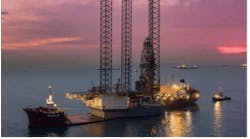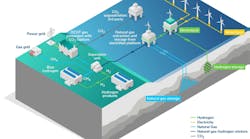THE OILAND GAS INDUSTRY was plunged into turmoil when oil prices crashed in 2014. To get back on track, it has been forced to devise and implement new ways of working and embrace new solutions in order to remain profitable, while the price of oil continues to fluctuate. At the same time, offshore operators and drilling contractors have had to step up efforts to reduce their environmental footprint so as to comply with new legislative demands, while at the same time seeking ways of shrinking their operating expenditures.
Effecting sustainable opex reductions is no simple matter. It involves careful risk management, better cost predictions, and an increased commitment to remote services in order to, for example, maximize the availability of equipment, optimize fuel costs, and prevent unforeseen issues. With the responsibility for fuel costs increasingly shifting from oil companies to drilling contractors, streamlining these services can have a favorable impact on the profitability of a contractor’s operations.
Smart technologies are available that enable step-changes in efficient and which provide environmental and financial benefits. One favored way for operators to reduce opex is to switch to unmanned offshore operations. Drilling contractors are moving in the same direction, however not at the same speed. One example is the ballast control room operator, which is no longer an individual role for the majority of floating drilling rigs as was the case in the past.
Increasingly technological enhancements are eliminating more personnel positions on rigs. Today technologies are becoming available for running engine control rooms fully unmanned, which is already a standard way of working in the marine sector. Manned engine rooms are enforced to ensure fast intervention in the case of a failure. The industry needs to recognize that technology has advanced, and blackout recovery situations are resolved more slowly with human intervention than with an automated sequence.
In the same way, primary DP operations are increasingly being moved onshore. DP operations can be handled in an onshore control center, lowering costs and increasing the flexibility for manning the position. Wärtsilä has successfully tested remote DP operations of an offshore supply vessel in the North Sea, controlled from San Diego, California. To draw on a parallel form outside the industry, remotely controlled military drones are now deployed routinely for combat operations across continents: in the same may remote offshore operations are now well established and proven to be technically feasible.
However, offshore drilling is also subject to stringent environmental legislation that has led to the industry being increasingly regulated. Environmental taxation, in Europe in particular, is a major motivator for the offshore sector to find new ways of reducing its carbon-dioxide (CO2) and nitrogen-oxide (NOx) emissions. Regulations will only get tougher, so ignoring this dilemma is no longer possible.
To reduce the environmental footprint, some level of capex investment is unavoidable. This however presents a challenge as the capex burden increasingly rests with the drilling contractor, whereas the lower opex achieved by reducing the environmental footprint tends to benefit the oil company. Until recently, oil companies have had to bear the cost of fuel as well as the taxes on CO2 and NOx emissions. However, a clear trend is now emerging whereby the fuel costs of drilling operations is shifting from the oil company to the drilling contractor and with it, the relevant taxes.
A sustainable reduction in energy consumption and emissions requires digital mapping and a baseline of the asset’s environmental impact. When this baseline is linked to the relevant energy consumption data, it is easy to identify improvement areas and to calculate the return on investment (ROI).
In the present uncertain scenarios, the oil and gas industry needs to find new ways of operating and new set-ups to ensure sustainable profitability. This requires joint efforts between oil companies, drilling contractors, and third-party service providers, with all sharing the gain or pain of an operation. When each party carries a share of the risk but also shares in the rewards, the motivation for collective success is high.
For service partners, it means looking beyond mere maintenance toward helping the oil company and the drilling contractor reduce their opex in a sustainable way, while at the same time improving the efficiency of their operations and ensuring better environmental performance. For drilling contractors, a growing awareness of, and attention to, the environmental footprint may well increase the costs of keeping operations sustainable at all times. On the other hand, a drilling contractor’s proven ability to deliver both environmental sustainability and low operational costs will, in today’s climate, increase its chance of winning the next oil company contract. •


